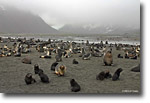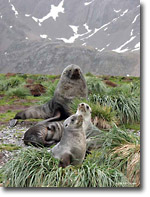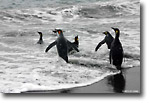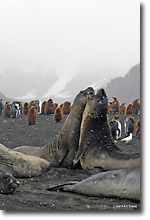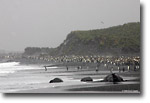Eden Below The Equator |
|
Fifteen years ago, we took a trip to Antarctica. It was a good trip, and we decided that it was a place weíd like to return. So, you might gather from that statement that this editorial is either about that trip or a subsequent trip to the same place. Well, it isnít.
In the course of researching that trip, we came across some references to South Georgia. It sounded like an interesting place, but trips there were few, far between, and very expensive. Fast forward to Christmas-New-Year, 2009-2010 and things have changed. Getting there is still expensive, but price breaks due to the economy temper that a bit and trips going are more frequent. That being the case, we were able to find a trip that got us there, and that we could afford.
South Georgia Island lies just below the intersection of 36į West Longitude, with 54į South Latitude. It's a semi-crescent shaped piece of continental crust split off from ancient Gondwanaland a couple of hundred million years ago. Surrounded by cold waters of the South Atlantic Ocean and Scotia Seas, itís a land of permanent winter with average summer temperatures in the 40ís (Fahrenheit). Three hundred plus days per year of rain or snow also make it a pretty wet place. All that moisture results in lots of green tussock grass, moss, lichens, etc. - but no trees. Itís a harsh environment with ice, snow, glaciers, and permanent cold. Compared with Antarctica to its south, however, itís a regular Garden of Eden. A butcher shop from the late 19th to mid 20th centuries (whales, seals, penguins, etc), it has now become a haven for Antarctic, and Sub-Antarctic wildlife. Year-round human residents (most of whom are engaged in scientific research), number about a dozen or so, and are located in King George Bay at the old whaling station of Grytviken.
The trip itself was run by Quark Expeditions (www.quarkexpeditions.com), a company specializing in Arctic and Antarctic trips, but we booked it through Elder Treks (www.eldertreks.com), a Canadian company specializing in trips for the over 50 crowd.
Proper dress (warm, lightweight, and layered) is very important. Landings are by Zodiacs and extremely wet, so waterproof outer garments including knee high rubber boots are also necessary. Equally important is protection for camera equipment (plastic bags, waterproof cases, etc). Personal first-aid kits should include something for the prevention and treatment of sea sickness. Travel is by ship, and force 9 winds combined with 18- or 19-foot swells can make even the strongest of stomachs queasy. Donít forget sunscreen and sunglasses or ski goggles. Sunlight (even on cloudy days) bouncing off snow and ice can be pretty blinding and can result in some serious burning.
Footnotes: Granted, youíre not trekking through the Himalayas, shooting the rapids below Victoria Falls (not sure if thatís been done yet), or climbing Denali, but this trip (and similar ones), are physically demanding and do take place in remote areas where proper (and timely) medical help may be limited or not readily available. Failure to take such facts into account when planning such trips is a recipe for disaster.
It was at South Georgia Island that Ernest Shackleton (one of the early 20th century polar explorers) and five others made landfall after an open boat journey from Elephant Island in Antarctica. The story of that journey, the sequence of events that led up to it, and the subsequent rescue, is one of the great sagas of polar exploration, and a testament to human endurance.
All images for this article were captured under existing conditions (rain, snow, good light, bad light, etc). The goal was to show the wildlife and the environment in which it lives, rather than what great photographers we are. Hopefully weíve done that.
Comments on NPN wildlife photography articles? Send them to the editor. NPN members may also log in and leave their comments below.
New York based Ezra (Izzy) and Carolyn Schultz took early retirement to pursue their passion for travel and photography. Their work has been exhibited at local photography shows, as well as several locations on the internet including NPN. They also have a website, www.naturalworldandfarawayplaces.com, where you can see more of their images.
